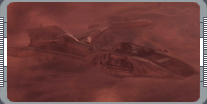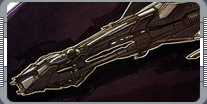
Designing the Klingon Raptor - By John Eaves.
The Klingons hadn't had a new ship for a decade, but things are very different in the 22nd century, so
Enterprise's producers decided it was time for a change.
 A new Klingon ship - a small scout vessel called a Raptor - made its debut in Enterprise's 'Sleeping Dogs.' As
a 22nd century ship it had to look more primitive than the battle cruisers and Birds-of-Prey that we
are familiar with, but at the same time it had to be instantly recognizable as a Klingon vessel.
A new Klingon ship - a small scout vessel called a Raptor - made its debut in Enterprise's 'Sleeping Dogs.' As
a 22nd century ship it had to look more primitive than the battle cruisers and Birds-of-Prey that we
are familiar with, but at the same time it had to be instantly recognizable as a Klingon vessel.
It was designed and built in Herman Zimmerman's art department, with John Eaves developing the basic shape in
sketch form and Doug Drexler refining the design as he constructed the CG model in Lightwave. Eaves explains
that he kicked off the design process by working up a series of quick sketches that Zimmerman could show to the
producers. "I really try to just come up with a shape that they can approve. I'll send things over that have
the right architecture in different configurations. In this case there was quite a gamut of shapes. Originally,
it was supposed to be a shuttle, then it got a little bigger as it went on. My thumbnails go from little
two-man sized things to four-guy ships, up to the one they chose, which I figure is like a 12-guy ship. It is
lightly based on the Bird-of-Prey, but more on the D-7."
 Once the producers had selected the design they wanted, Eaves handed the appropriate drawing on to Drexler. He
says that, since Drexler sits only a few yards away from him, he only produced a single view of the Raptor. "If
it was a sketch that was going to be sent up to Foundation [Imaging] or Eden FX, I'd give them more drawings.
I'd give them, side, top, all that stuff. For Doug I don't do that because we can talk back and forth about it.
It's a real fun collaboration, even though once I give it to him it's pretty much his at that point." This
sketch showed the Raptor in a fair amount of detail, and clearly established it as a 22nd century
design. Eaves says that by now he had a fairly clear idea of what he had to do to make it look more primitive
than the ships we are used to. "For me there are three periods of design - there's exposed piping and stuff on
the early, early, Archer stuff; the Kirk stuff had smooth panels; then, because of the giant scale of the ships,
there's just heavy panel breakup on the Picard-era stuff."
Once the producers had selected the design they wanted, Eaves handed the appropriate drawing on to Drexler. He
says that, since Drexler sits only a few yards away from him, he only produced a single view of the Raptor. "If
it was a sketch that was going to be sent up to Foundation [Imaging] or Eden FX, I'd give them more drawings.
I'd give them, side, top, all that stuff. For Doug I don't do that because we can talk back and forth about it.
It's a real fun collaboration, even though once I give it to him it's pretty much his at that point." This
sketch showed the Raptor in a fair amount of detail, and clearly established it as a 22nd century
design. Eaves says that by now he had a fairly clear idea of what he had to do to make it look more primitive
than the ships we are used to. "For me there are three periods of design - there's exposed piping and stuff on
the early, early, Archer stuff; the Kirk stuff had smooth panels; then, because of the giant scale of the ships,
there's just heavy panel breakup on the Picard-era stuff."
 In this case, because the Raptor is clearly related to the D-7 battle cruiser that appeared in the original
series and the movies, Eaves was able to work backward from a familiar design. He explains that his
22nd century design ethic instantly gave him a sense of how to modify the architecture without
interfering with the basic shapes. "The original D-7 had more body than wings. In the older stuff, I'm trying
to show that wings were kind of state of the art at that time. They don't need to be aerodynamic in any way,
but I really try to do wings for anything I can, like the
[Enterprise NX-01] shuttle for instance. The first thing I try to do
is make the wings bigger and thin them out a bit. Then I try to make sure that the ship looks more like it is
made up of different pieces that are attached to one another, as opposed to a uniform shape. With the Klingons
I'm also doing this Golden Gate bridge thing where there's exposed cabling that holds everything together.
That's a rough trademark I'm trying to put on all the Klingon stuff." Eaves adds that Drexler continued to
refine the design as he built the model. "I think it's great the way Doug interprets my drawing and adds what
he thinks the past should look like. Even though the shape was approved, the details - the shuttlebays and all
the little neat things - were pretty much in his hands." As Drexler explains, his job wasn't to make any
alternations to the shape, but to reinforce the overall impression the producers wanted to create. "For me, the
Raptor has a PT boat-Civil War ironclad quality to it. John's sketches suggested a trussed and cabled quality
that I was sure to include in the model. Those distinctive touches helped to date it. The coloration is
metallic, but suggests the gray tones of Matt Jefferies' original battle cruiser. Japanese submarine
rusty-green of later years."
In this case, because the Raptor is clearly related to the D-7 battle cruiser that appeared in the original
series and the movies, Eaves was able to work backward from a familiar design. He explains that his
22nd century design ethic instantly gave him a sense of how to modify the architecture without
interfering with the basic shapes. "The original D-7 had more body than wings. In the older stuff, I'm trying
to show that wings were kind of state of the art at that time. They don't need to be aerodynamic in any way,
but I really try to do wings for anything I can, like the
[Enterprise NX-01] shuttle for instance. The first thing I try to do
is make the wings bigger and thin them out a bit. Then I try to make sure that the ship looks more like it is
made up of different pieces that are attached to one another, as opposed to a uniform shape. With the Klingons
I'm also doing this Golden Gate bridge thing where there's exposed cabling that holds everything together.
That's a rough trademark I'm trying to put on all the Klingon stuff." Eaves adds that Drexler continued to
refine the design as he built the model. "I think it's great the way Doug interprets my drawing and adds what
he thinks the past should look like. Even though the shape was approved, the details - the shuttlebays and all
the little neat things - were pretty much in his hands." As Drexler explains, his job wasn't to make any
alternations to the shape, but to reinforce the overall impression the producers wanted to create. "For me, the
Raptor has a PT boat-Civil War ironclad quality to it. John's sketches suggested a trussed and cabled quality
that I was sure to include in the model. Those distinctive touches helped to date it. The coloration is
metallic, but suggests the gray tones of Matt Jefferies' original battle cruiser. Japanese submarine
rusty-green of later years."
 Once Drexler had finished his work on the model it was handed over to Foundation Imaging, where modeler Pierre
Drollet and his supervisor Rob Bonchune finished it to the nth degree and finally added the damage that was
called for by the script. Eaves concludes by saying that he was delighted with Drexler's work, which he thinks
"compliments" his design in every possible way. "Even though we work in different mediums, we think a lot alike
about the details, but what he's able to do with the computer is a whole world I can't really perceive. He turns
those goofy sketches into a far better design that I would have done."
Once Drexler had finished his work on the model it was handed over to Foundation Imaging, where modeler Pierre
Drollet and his supervisor Rob Bonchune finished it to the nth degree and finally added the damage that was
called for by the script. Eaves concludes by saying that he was delighted with Drexler's work, which he thinks
"compliments" his design in every possible way. "Even though we work in different mediums, we think a lot alike
about the details, but what he's able to do with the computer is a whole world I can't really perceive. He turns
those goofy sketches into a far better design that I would have done."
|
|
"DESIGNING THE KLINGON RAPTOR" - JUNE 2002 ISSUE 38 STAR TREK: THE MAGAZINE COPYRIGHT OF PARAMOUNT PICTURES.
|